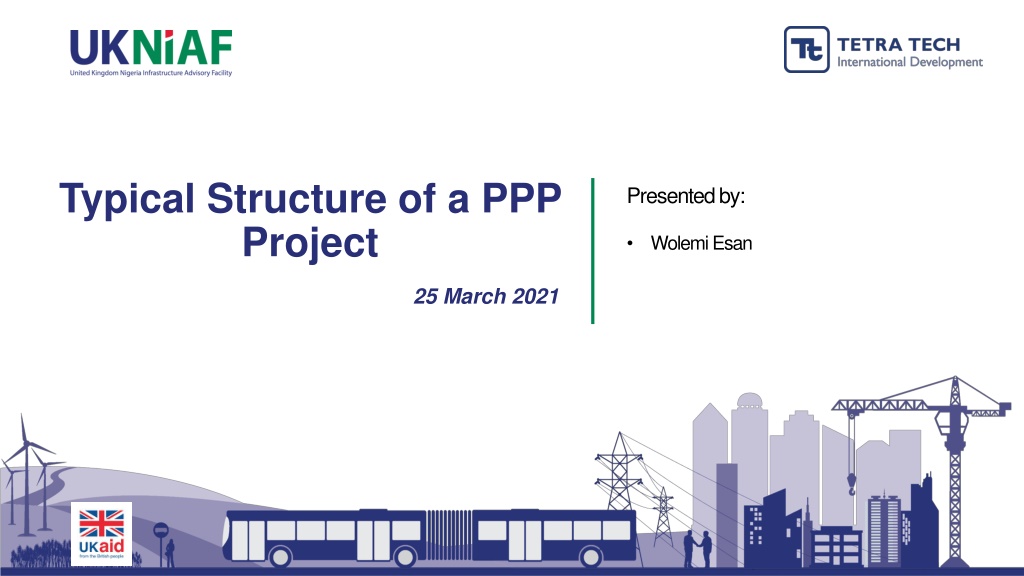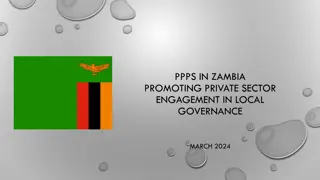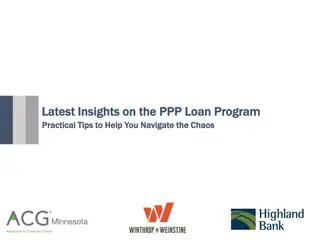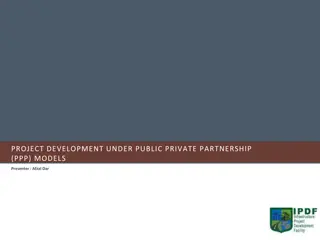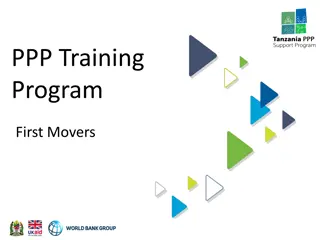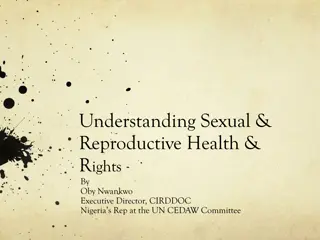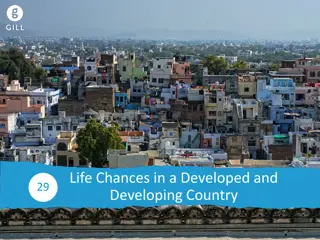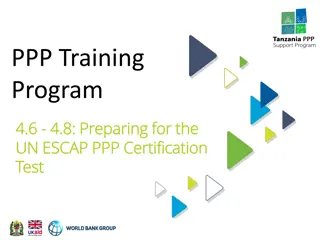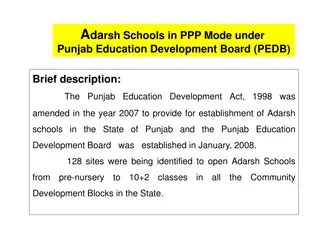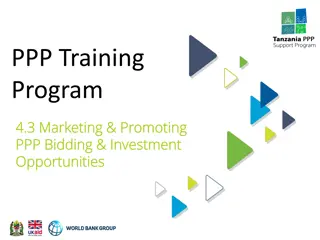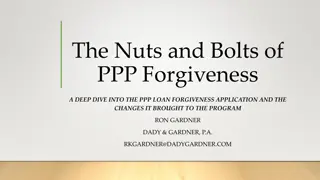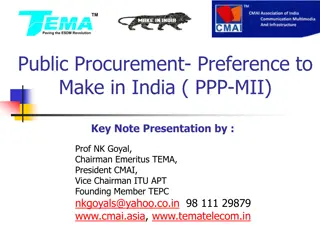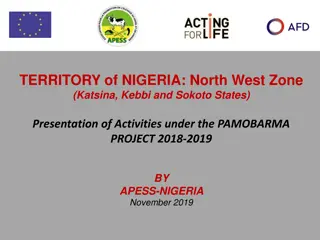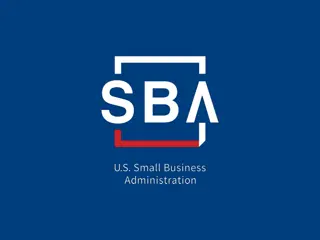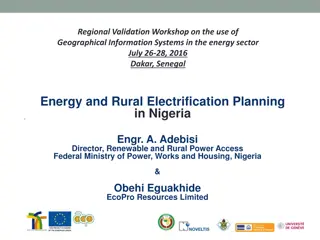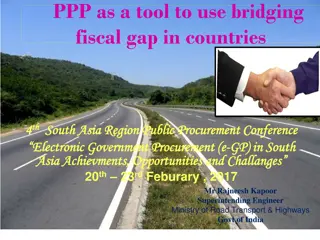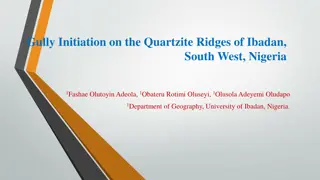Understanding the Typical Structure of PPP Projects in Nigeria
PPP projects in Nigeria play a significant role in infrastructure development, with various models like BOT/BOOT and DBFOMT being commonly utilized. Private entities build, operate, and may transfer facilities to the government, driving economic growth through private sector participation. Key contracts, financing, and flow of funds are essential aspects to grasp for stakeholders involved in PPP arrangements.
Download Presentation

Please find below an Image/Link to download the presentation.
The content on the website is provided AS IS for your information and personal use only. It may not be sold, licensed, or shared on other websites without obtaining consent from the author. Download presentation by click this link. If you encounter any issues during the download, it is possible that the publisher has removed the file from their server.
E N D
Presentation Transcript
Typical Structure of a PPP Project Presented by: Wolemi Esan 25 March 2021
Introduction PPPs can be somewhat complex arrangements and it is important that stakeholders (public and private alike) have a sound understanding of a typical structure of PPP Project In Nigeria, PPP arrangements are commonly used by Federal and State Governments to deliver key social and economic infrastructure projects in various sectors. PPP is a widely recognised tool for encouraging private sector participation in public infrastructure projects, reducing funding gap, promote infrastructure development and contribute to economic growth
Learning Objectives Parties in a PPP Arrangement Step.1 Key Contracts Underpinning a PPP Project. Financing and flow of funds in a PPP Project
Forms of PPP Models PPP Models Description This structure entails the development and construction of the facility by the private entity in accordance with specifications set out by the government entity. The private entity then operates and manages the facilities for a term of years to recoup its investments from user charger. The private entity retains ownership of the facility until the expiration of the agreed term of years on the expiration of which the private party is obligated to transfer the assets back to the government entity. Build-Operate-Transfer (BOT)/Build-Own-Operate- Transfer (BOOT) Under this structure, the private entity builds the facility in line with specifications provided by the government entity, and transfers ownership of the facility to the government upon completion of the construction. In return, the government entity grants the private party a right to operate and manage the facility for a number of years, usually in the form of a long-term lease. In the course of its operation of the assets, the private party may recoup its investments by way of tolls and user charges. Build-Transfer-Operate (BTO) In practical terms, the ROT/ROOT are typically the same with the BOT/BOOT save for the fact that the ROT/ROOT entails the rehabilitation of pre-existing facilities brownfield projects, while the BOT/BOOT relate to fresh projects or facilities greenfield projects. This PPP model is particularly attractive to investors as the facilities to be revamped, upgraded or expanded already have a demand history which will significantly reduce market risks. Rehabilitate-Own-Transfer (ROT)/Rehabilitate- Own-Operate-Transfer (ROOT) The private entity is responsible (and bears the risk) for the development, design, construction, financing, operation and maintenance of a PPP project for a specified period of time. The public sector entity on the other hand remains the owner of the asset. The private entity may be paid by the end users of the project (e.g. by the collection of tolls), or by the public agency. The major difference between the DBOM structure and the DBFOMT structure is that under the DBFOMT structure, ownership of the asset is vested in the private entity. At the end of the project period, the ownership, operation and maintenance of the project is then transferred to the public sector entity Design-Build-Operate-Maintain(DBOM)/Design- Build-Finance-Operate-Maintain- Transfer(DBFOMT)
Typical Structure of a PPP Project Government Concession Agreement Shareholders Agreement/JV Agreement Loan & Security Agreement Lenders Project Company/SPV Sponsors Equipment Supply Contract Design & Construction Contract Operator & Maintenance Contract Supplier Contractor Operator
Parties in a PPP Project Project Company/SPV Project Company/SPV (Private Party) Who sets up the SPV? A corporate vehicle (i.e., a limited liability company) that has been set up specifically for executing the PPP Project. The implication is that such company will be unable to carry out any activities outside the scope of the specific project Project Sponsors/Promoters usually the preferred bidder/consortium that emerges from a solicited procurement process. The preferred bidder/consortium will take up equity stake in the Project Company/SPV Benefits of using a SPV Functions of the Project Company/SPV Off balance sheet Financing for the equity investors For the procuring authority, the creation of the SPV helps to ensure that there is an entity solely dedicated to the project. Execution of the PPP Contract (Upstream Contract) and other key contracts in a PPP project Execution of the Downstream Contracts (i.e., Construction/Engineering Procurement and Construction (EPC) Contract and Operations & Maintenance (O&M) Contract
Parties in a PPP Project Government Government (Public Authority) The Government or procuring authority is the public partner in a PPP arrangement. The role of the procuring entity in a PPP arrangement is crucial and ranges from project identification at the inception of the PPP process all the way to contract management and the hand-back of the asset by the SPV. For PPP Projects in Nigeria, there are 3 relevant government agencies that are involved in managing a PPP Project: Bureau of Public Enterprises (BPE) The relevant Ministry, Department & Agency (MDA)procuring the Project Infrastructure Concession Regulatory Commission (ICRC) The BPE and relevant MDA will execute the PPP contract on behalf of the Government The ICRC on the other hand, is the primary regulatory agency for PPP projects in Nigeria. It manages the entire PPP project from inception to conclusion. It also has powers to inspect and monitor projects to ensure that the terms of the PPP contract are being complied with as well as applicable laws and regulations. Functions of the Government Some functions of the Government in a PPP project include: Monitoring and Contract Management through the ICRC Assist SPV to procure relevant permits and approvals Provide tax and other economic incentives to the SPV Assist SPV in land perfection matters
Other Key Parties Parties Features Functions SPONSORS/EQUITY INVESTORS Provides financing/capital to the Project These are the Project Sponsors/Promoters that take up equity or shares in the SPV. In exchange for shares allotted to them in the SPV they provide capital for the project. It should be noted that the government could be an equity investor in PPP projects, albeit a minor equity holder. Presence of government equity ownership can help the SPV attract necessary 3rd party financing for the PPP project. Also, it is important the sponsors/equity investors take up enough equity in the SPV (i.e. standard commercial practice dictates at least 30% equity) . Lenders would be more willing to lend to the SPV if they see that the debt-equity ratio is not high. LENDERS Provides external/3rd party financing to the PPP Project. Lenders provide external financing to the SPV for the development of the project. Lenders can include commercial banks, multilateral development banks, development financial institutions etc. CUSTOMERS/END USERS Fees paid by customers/end users provide a revenue stream for the Project Ultimate beneficiaries of the asset or infrastructure being constructed and operated by the SPV. CONTRACTORS Responsible for the actual construction and operation of the project. These are the parties that will directly undertake the construction and operation of the project pursuant to the downstream contracts Usually two sets of contractors to cover the construction phase and operations phase of the Project Crucial for optimum risk allocation in a PPP
Contracts underpinning PPP Projects PPP Contract (Upstream Contract) This is the primary contract in a PPP project and the foundation on which the entire PPP arrangement is built. The structure of the PPP project and all the terms of the partnership between the public and private party are stated in the PPP Contract.
Contracts underpinning PPP Projects PPP Contract Key Provisions Key Provisions Description The procuring authority authorizes or grants the private party right to execute the project. Grant of Concession Rights and Concession Period The PPP contract also provides for the duration of the concession period. The concession period is constituted of the construction phase and operations phase of the project. At the end of the concession period, the private party will transfer over ownership, management and control of the asset to the procuring authority This covers the mechanisms for revenue generation and for determining the appropriate tariffs to be collected by the SPV This is typically keenly negotiated, as it will form the economic basis of the project and the central business case for lenders, and other investors in the project. Revenue Generation & Tariff This section deals generally with the key payments to the granting authority which form the consideration for the grant of the concession, and the PPP arrangement. The scale of fees and other payments may be agreed and set out in a schedule to the concession agreement Payment Towards the end of operation phase of the PPP project, the Project Company/SPV will begin plans to transfer or hand over the management and control of the facility/asset over to the government pursuant to the terms of the PPP contract. The PPP contract will provide for a hand over procedure that the private party is expected to follow to effectively hand over or transfer the ownership and control of the facility or asset to the procuring authority. Hand Back provisions
Contracts underpinning PPP Projects Lending/Loan Agreements - Given that PPP projects are highly capital intensive, the SPV will likely have to obtain 3rd party debt financing from financiers such as commercial banks, development finance institutions (DFIs) and other funding organisations. The SPV will enter into loan agreements with these financiers to obtain necessary financing for the project. Downstream Contracts EPC and O&M Contracts The SPV enters into a Construction/EPC Contract and an O&M contract to cover the construction and operation phases of the project. SPV is in effect transferring the relevant obligations under the main PPP contract to the EPC and O&M Contractor, but remains liable for breach under main PPP Contract. SPV should as much as possible ensure the downstream contracts mirror its obligations under the PPP contract to ensure that it does not breach its obligations under the PPP contract. The Financiers will also require the SPV to enter into a number of security agreements to secure the SPV s debt obligations.
Typical Structure of a PPP Project Government Subsidies and Availability Payments Loans, Bonds Debt Service Service Payments Design & Construction EPC Contractor Lenders Project Company/SPV Investment Dividend Service Payments Operation & Maintenance O&M Contractor Equity Investors User Fees Services Users Credit: https://pppknowledgelab.org/guide/sections/17-finance-structures-for-ppp
Financing and flow of funds in a PPP Project Government Under PPP arrangements, government financing to the project can be beneficial in the following ways: Private Sponsor/Equity Investor In addition to cash, private sponsors could contribute in terms of technical know-how and expertise on the project. In a number of cases, the EPC contractor on the project could also be one of the private sponsors/equity investor in the SPV. Concessionary financing costs Government as an equity investor in the SPV will be better placed to access loans at lower market rates on behalf of the project Other equity investors that are not sponsors of the project may take up equity/shares in the SPV. These are usually private equity funds who would invest in the project for a fixed period of time and exit the project after such period by selling their equity stake in the project. Risk Reduction Provision of financing by the government reduces the risk and exposure of the private party which ultimately have a beneficial impact on the entire costs of the project Availability of Funds Where there may be scarcity of funds, government can step in to provide financing to prevent project from stalling.
Sources and flow of funds in a PPP Project Multilateral &Development Financial Institutions and Donor Organisations Commercial Banks Commercial Banks are also possible financiers for a PPP Project. Some possible issues with Commercial Banks financing in Nigeria are:: Provision of loans, grants, credit guarantees etc., and much needed technical and financial advisory services given their vast experience in developing infrastructure projects globally. High interest rates. Reluctance to provide long-term financing packages Typical for funding to be provided by a syndicate of banks. Grants provided by institutions such as the World Bank or other donor organisations like the MacArthur Foundation. Grants can make a project bankable and more appealing to private sector investors and local lenders. Grants also drive the development of projects that provide necessary economic and/or social benefits, such as environmental (renewable energy production) and/or social (poverty reduction) welfare centric projects.
